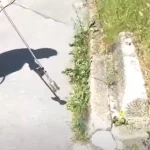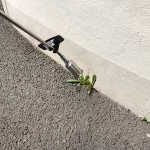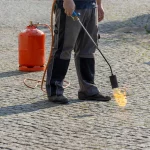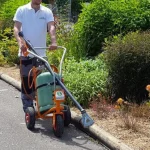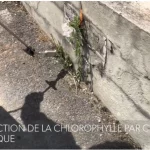There are different weed control methods, which are more or less expensive, effective and environmentally friendly. Here are the main ones.
Chemical weeding
Chemical weeding is being used less and less and is disappearing. Its use is already very restricted by law and many products have been withdrawn from sale.
Chemical weeding is expensive and especially catastrophic for the environment. It spreads by capillary action, which can harm an entire area. It kills the underground fauna, essential for the regeneration of soils, and pollutes the water tables. So it’s time to forget about that.
Manual weeding
Manual weeding remains the most natural and environmentally friendly method. It is reserved for small areas, because you are not going to handle an entire municipality, but it already allows large green spaces to be maintained using efficient mechanical tools.
The hoe
The sharp blade at the end of the hoe handle creates a clear border to define a green space. It slices both leaves and roots and can be used for fairly large areas.
Digging fork
The digging fork is a hand tool that can be used to maintain flower beds and eradicate weeds.
Weeding trowel
The weeding trowel looks like a long fork with two tines and is used for flower beds. By planting it deep into the soil, you reach the roots.
Mulching
Mulching limits weed growth around plant and shrub beds. It is advisable to spread a special tarpaulin (which allows moisture to pass through) and then mulch with bark, stones, pebbles, etc.
Weeding with hot water or steam
This technique involves using very hot water – or steam – at low pressure and spraying it on the plants. It is only effective on waterproof surfaces. Water (and fuel) consumption is very important, especially since several passes are required.
Whether using water or steam, both methods are to be avoided. The investment in equipment is high and, above all, water is far too precious to use in this way.
Hot foam weed control
Hot foam weed control uses water to which a biodegradable solution of corn and coconut starch is added. This should be heated to around 100°C to create a very hot foam to be sprayed on the plants to be removed. The temperature shock caused by the foam causes the plant to die within a quarter of an hour.
The advantage over the pure water of the previous method is that the foam can also be applied to a permeable surface. It is also faster and requires fewer passes. However, as water (and fuel) consumption remains very high, it is not at all environmentally friendly.
Thermal weed control
Thermal weed control consists in creating a thermal shock that makes the plant cells explode, without burning the plant. The proteins in the plant cells coagulate and photosynthesis is naturally stopped.
The thermal weeder uses propane gas, which is inexpensive and non-polluting. It usually requires two passes to completely dry out the plant. The manoeuvrability of the device makes it possible to treat large areas, whatever the landscape.
The investment is low, with a device that does not then require any maintenance or servicing.
The only reservation to the use of the thermal weeder is for dry brush areas that cannot be treated because of the risk of fire.

